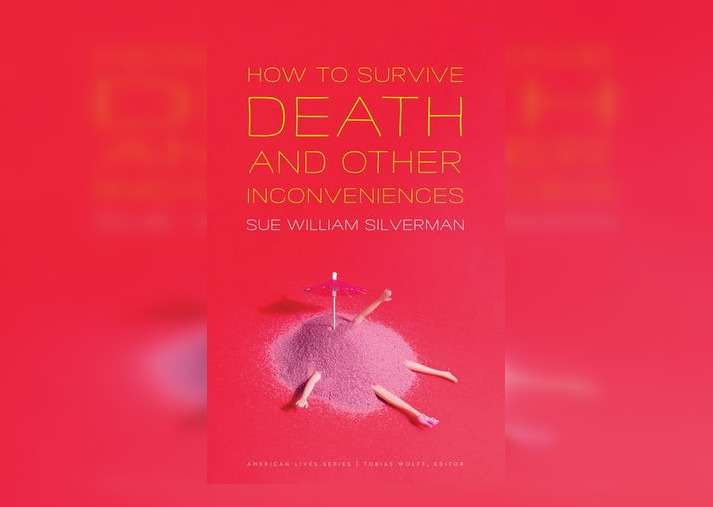Sue William Silverman opens How to Survive Death and Other Inconveniences with a road trip in her gold-finned Plymouth, “cruising through life” down Route 17 as a teen, “planning to never stop.” Throughout this memoir/thematically linked essay collection, Silverman shows us that, metaphorically, she is still that restless young woman behind the wheel. Poring over an old atlas, Silverman can trace the places and episodes of her difficult past to map the urgency and central drive of the book: what explains the narrator’s life-long fear and obsession with death, and what does it mean to survive?
Silverman establishes her parameters upfront. She does not believe in God or an afterlife and rejects using words such as “void,” “abyss,” “nothingness,” or “oblivion,” as she finds them too abstract. To survive death, the narrator undergoes a mission to preserve her memories, revive herself, and to invoke the power of words in this process: “I give memories structure, resurrect them, like a new life-form, examine them anew.”
The memoir is divided into three sections, each represented by a Fate: Clotho (who spins the thread of life), Lachesis (who measures how long a person will live), and Atropos (who cuts the thread to decide how someone dies). Far from traditional and gloomy, however, the narrator resists melodrama despite the dour subject through humor. A few examples:
Hemingway said all true stories end in death. But he wasn’t from Jersey, so what did he know?
What I really want is not to be composed of matter at all. I want to be reborn increately, or re-created without a body. And soon. Because in the span of a few years this very un-increately body seems determined to liquidate itself with the speed of a going-out-of-business sale.
My ability to worry is the one aspect of me that will never grow old.
Even if I die (I’m still holding out for if!) I’ve finally gathered together all my various selves—words and memories—which comprise the past. So this is my confession, my testament, because, if I have to go, I’m not going quietly.
Silverman also achieves a fresh rendering of death as a subject through juxtaposition and collapsing time—showing us what death is and what death is not. For this narrator, the opposite of death means attending an Adam Lambert concert, “suspended between… age” as she observes a sleeping older woman in a wheelchair alongside Lambert’s youth while the middle-aged narrator absorbs a sense of the singer’s “timelessness, his never-ending now.” The opposite of death means saving the contact information of deceased friends and loved ones, because their emails are still theirs. The opposite of death means a fierce affection for a cat named Quizzle. The opposite of death means wanting “three hearts like an octopus: three times the longing, three times the regret. But also three times the love, three times the life.” The opposite of death means having the audacity to “stare past” a man during sex, to instead remember a nightscape memory featuring a white horse, to instead imagine breathing “deeply enough to inhale stars” to escape the violence being done to her body.
These stories illuminate what is otherwise quite abstract to convey: what it means to live, and bravely, especially in the wake of so much pain. The narrator wants to know “how to live. Not just exist.” She also comes to learn that “To live you have to be wounded.” Silverman has experienced more than her fair share of wounds. Though we relish her embodied, electrifying experiences of feeling incredibly alive in many passages, these do not minimize her harrowing traumas. In the narrator’s words, “Death terrifies me. Yet I constantly live or recall miniature forms of it: heartbreak and pain sung to a country-western beat.” These micro-forms of death are interrogated throughout as the narrator examines her past.
The recurring haunts of this memoir feature a miscarriage after a “knife-thin” man raped the narrator as a teen, two experiences for which she learns to not blame herself. But the narrator has other “guardian devils.” The narrator “die[s] at age four” when her father began to sexually abuse her. “To survive death,” the narrator says, “I must first survive my father.” At various points in the narrative, she suffers from disordered eating, sex addiction, alienation, abandonment, shame, a suicide attempt, hypochondria, and divorces. Throughout, there seems to be an underlying theme of loss—loss after loss after loss.
I have lost enough; therefore, I have already died enough.
In the shadow of loss, however, there is also an equally powerful theme of the narrator’s tremendous resilience against physical, but also emotional violence, waged against women. She rejects the notion that women manage to “always [be in] the wrong place, always [at] the wrong time.” From an early age, the narrator resists the status quo. In a piano lesson, the child narrator enjoys improvising. Her teacher scolds, “We don’t play by ear. We play by what’s in the book.” That we, throughout the memoir, feels gendered, an attack on the narrator’s innate restlessness as a teen driving her Plymouth down Route 17, hungry for freedom and full-hearted living. Later, when the narrator contemplates her loveless marriage, she asks, “Am I unable to be a wife simply because I never learn to cook or sew? I never have children. I never learn things that seem more or less second nature to other women.” Home itself becomes elusive, a secondary quest for the narrator. Silverman reckons with her restlessness, that she “doesn’t know how to stop” because a part of her is unwilling to settle, to stop seeking and searching for something better than “perfectly fine.” Route 17 becomes the narrator’s own body, her own version of home: “my veins themselves are miniature interstates, blood rushing… never stopping. I drive on blind faith that these highways will eventually arrive at some point that’s real—one that answers seemingly unanswerable questions—so that I’m no longer merely following lines on a map.” She will drive—live—until the road is fully her own. It is no wonder she is uninterested in meeting the end.
The interrogations throughout the memoir retain their universality despite the sharp specifics of the narrator’s life:
If my body has a breakdown, am I left as only a footnote or erasure? A blank page? I plan to never find out.
I’m faced with the trite but nonetheless frightening thought that life itself is a waiting room: waiting for breakfast, for school to start, for marriage or divorce. Waiting for an airplane to depart, for a concert to begin, for a parent to die, for a phone call with bad news, for an email with good news. Waiting, waiting, waiting…”
Remember everything. Forgetting is a form of death.
Is death the inability to write a full sentence
Do I particularly fear death because I’ve never fully figured out—discovered—life?
These are sincere questions, though by the close of the memoir, it becomes evident that the narrator has done more honest living and examining than most. She has survived over and over again. She honors her mission from the onset, to use words and language to resurrect experience in all its contours. In doing so, she illuminates the universals we all crave, to understand death through the lens of what it means to exist. Silverman undertakes the questions some of us are too afraid to ask, and we find ourselves rooting for her, flying down Route 17, because in doing so we are also rooting for ourselves.




